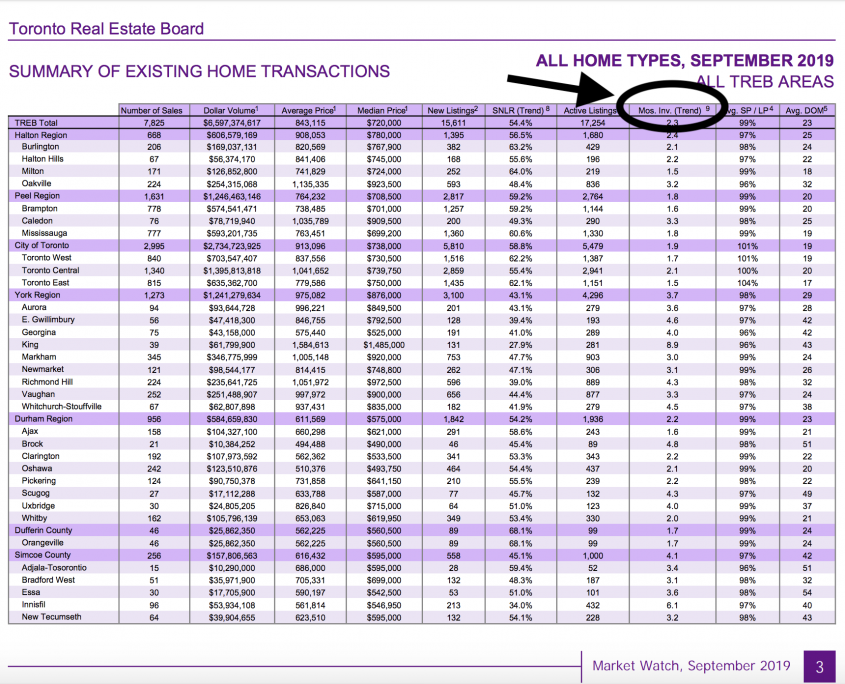Among the many buzz words in the real estate industry, Absorption Rate, also referred to as ‘Month’s Inventory” is a term rarely mentioned in real estate but can be very helpful in understanding the current market, which can help any home buyer or seller better negotiate their real estate deal.
In this article I’ll explain how absorption rate is calculated, and how you can use it to put more money in your pocket in real estate!
What is Absorption Rate
First off, before we can understand how to use this statistic, we should quickly go over what absorption rate is. Unlike other commonly looked at real estate statistics such as average days on market or sold to ask ratio, Absorption rate, or Month’s Inventory tries to help predict how the market will perform in the foreseeable future.
Simply put, absorption rate is way to measure the rate at which available homes are being sold in a specific market over a specific time frame. Usually measured in months, this simple calculation measures how many homes are sold are sold in a month versus how many homes are actively for sale.
By calculating the absorption rate you can figure out how long it will take to sell all of the homes currently listed for sale if market conditions remain the same.
How to Calculate Absorption Rate
It’s quite simple, take the amount of listings in a month and divide that number by the amount of sales in that month.
For example, let’s say there are 20 homes for sale in a neighbourhood and only 5 sold. 20 divided by 5 equals 4. That means if market conditions remain the same, it should take 4 months to sell of all the existing homes for sale.
In this example, most real estate agents will refer to this as 4 months’ worth of inventory.

In this example from the Toronto Real Estate Board Market Watch Report, you can see “Month’s Inventory” which is obtained by calculating the Absorption Rate.
How to Interpret Absorption Rate
Ok, so if you’ve made it this far you may be thinking, “ok, so how do I use this info?” So now I am going to go over how to interpret absorption rate.
In real estate, there are 3 types of markets you can experience. Depending on the amount of inventory available for sale (obtained by calculating the absorption rate) you can determine what type of market you’re currently in, and what prices should do over the foreseeable future.
Below is a breakdown of the 3 different types of real estate markets.
Seller’s Market
When the month’s inventory is low, this means that homes are selling quickly. When this happens we in the real estate industry refer to this as a “Seller’s market” which means the advantage goes to the seller. In these types of markets the prices rise as the lack of supply combined with high sales forces prices up.
In real estate, a market with 0-4 months’ worth of inventory is considered a “sellers market”. It’s important to know that not all real estate markets are the same, and the rate of price increase will change with how low or high this number is.
So if there’s 4 months of inventory we might expect moderate price increases, while if there’s only 2 months’ worth of inventory we will see sharper price increases and other things such as bidding wars and bully offers.
Balanced Market
At 4-6 months worth of inventory we refer to this as a “balanced market”. That means homes are selling a little slower, but there is still demand. In this market prices tend to remain flat, with no advantage to either buyer or seller.
Buyer’s Market
Once the amount of inventory available for sale climbs above 6 months we are entering a buyer’s market. This means there are a lot of homes for sale and not many sales. Homes take longer to sell and seller’s start to reduce their prices in order to attract buyers. If you’re ever wondering if prices will start to go down, having an absorption rate of over 6 is a good indicator.
How to use Absorption Rate to Negotiate and also to Forecast the Future
So now that we’ve gone over how to calculate absorption rate and what it means, I am going to go over quickly how to use this information to your advantage.
First, if you’re buying or selling a home it’s important to know what type of market you’re in. For example if you’re in a “sellers market” and you’re buying a home, you will want to keep in mind that you should act quickly as there’s a good chance you could be in multiple offers.
On the flip side if it’s a “buyer’s market” you may be more inclined to negotiate a lower price with confidence, knowing homes aren’t selling that fast. If you’re a seller you may want to double down on marketing and presentation by concentrating on home staging to attract more buyers.
Secondly, if you’re trying to predict how prices are going, Absorption Rate is a good indicator. Perhaps your market has been slow or balanced but the inventory has suddenly dropped. This is a good indicator that prices will start to rise in the near future.
On the other hand, if you notice month’s inventory start to climb this is an indicator that prices will stabilize or even drop in some cases. Regardless of the market, knowing this fact can help you make the best decision for you and your real estate needs!
I hope you enjoyed this article on Absorption Rate in Real Estate. If you have any questions about real estate or the Mississauga Real Estate Market always feel free to contact me!








